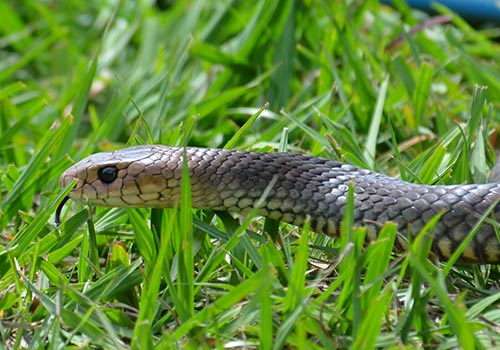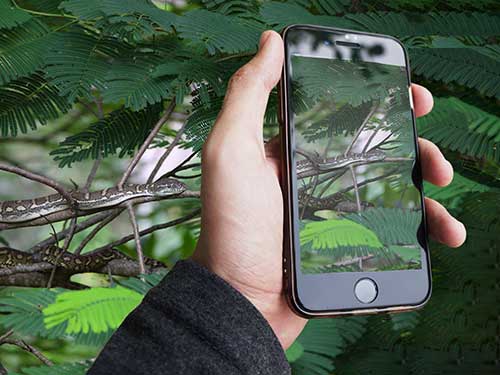Bites from the Eastern Brown snake have caused human fatalities. In fact the Eastern Brown Snake accounts for more fatalities than any other Australian Snake. A nervous, ready biter it will defend itself if threatened. Maintains a strong defensive “S” shaped posture. The Eastern Brown Snake is the second most toxic land snake in the world and the most venomous in South East Queensland. Bites from this species should be treated immediately and attended to with correct first aid.

Highly variable in colouration and pattern. Colour ranges from pale tan through orange, russet, dark brown & almost black, sometimes with cross-body banding. Belly usually cream, yellow or orange with scattered orange or grey blotches. Hatchling and juveniles particularly vary in colour, frequently having dark heads or neck bands, or being completely banded along the body length. Midbody scales at 17 rows.
1.4 metres but a specimen of 2.3 metres was recorded from Karalee in South east Queensland by a brisbane snake catcher. Snakes in excess of 1.8 metres are very uncommon.
Wide range of habitats but generally prefers drier habitat. Dry open forest, wood and shrub-land, grassland, farmland. Very successful in agricultural regions where tree clearing & introduction of mice and rats has created ideal habitat & abundance of food.
Diurnal, active hunter but has been seen active on hot nights. Not regarded as a climbing species but may occasionally climb in search of potential prey. Quick to retreat most specimens are usually seen disappearing into available cover.
Primarily small mammals (rats, mice etc) but also lizards and occasionally frogs.
Most common large venomous snake. Readily occurs in all but the inner suburbs of Greater Brisbane but especially to the west throughout Ipswich and the Lockyer and Brisbane Valleys. However recent captures by snake catchers have recovered specimens as close to Brisbane CBD as Indooroopilly and Taringa. Common along bayside suburbs to the north and south including the Gold Coast and Sunshine Coast.
Often encountered in and around localities with a strong rodent presence such as bird aviaries and stock feed sheds. Due to its active foraging nature it often enters homes through gaps afforded to it by open or gaps under doors. Any ground refugia may be utilised such as timber piles, sheet iron, rock walls and heavy vegetation. The maintenance of yards and the control of spilt seed and other food associated with pets may assist in the control of rodents which this species exploits so well.
Enjoy our ID photo gallery for this species.
Our gallery is pulling in the photos from Dropbox so please be patient and it will only take a few second while gallery loads. Clicking a photo will open the lightbox viewer, please allow a few second between each photo as most photos are a larger file size to retain their quality and size for your best viewing experience. If blank spaces appear in gallery main section please click on the refresh icon at the top left of gallery. All photos are the property of the website or respected owner and can not be re-used without permission. Copyright laws applies.
For our snake identification service simply click the button below to go to our photo ID upload page. We provide our Australian snake identification service free of charge and always welcome high quality images for potential inclusion on our website. This service is not just for Queensland snake identification but for all snake id across Australia.
